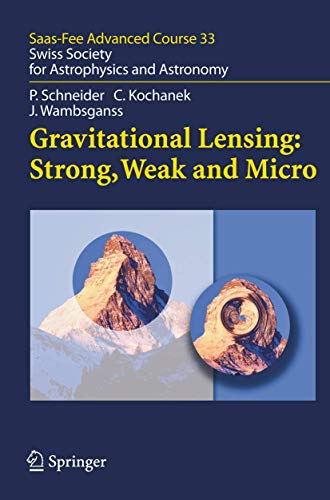Gravitational Lensing: Strong, Weak, And Micro - Couverture rigide
Livre 13 sur 26: Saas-Fee Advanced Course
Synopsis
The observation, in 1919 by A.S. Eddington and collaborators, of the gra- tational de?ection of light by the Sun proved one of the many predictions of Einstein's Theory of General Relativity: The Sun was the ?rst example of a gravitational lens. In 1936, Albert Einstein published an article in which he suggested - ing stars as gravitational lenses. A year later, Fritz Zwicky pointed out that galaxies would act as lenses much more likely than stars, and also gave a list of possible applications, as a means to determine the dark matter content of galaxies and clusters of galaxies. It was only in 1979 that the ?rst example of an extragalactic gravitational lens was provided by the observation of the distant quasar QSO 0957+0561, by D. Walsh, R.F. Carswell, and R.J. Weymann. A few years later, the ?rst lens showing images in the form of arcs was detected. The theory, observations, and applications of gravitational lensing cons- tute one of the most rapidly growing branches of astrophysics. The gravi- tional de?ection of light generated by mass concentrations along a light path producesmagni?cation, multiplicity, anddistortionofimages, anddelaysp- ton propagation from one line of sight relative to another. The huge amount of scienti?c work produced over the last decade on gravitational lensing has clearly revealed its already substantial and wide impact, and its potential for future astrophysical applications.
Les informations fournies dans la section « Synopsis » peuvent faire référence à une autre édition de ce titre.
Autres éditions populaires du même titre
Résultats de recherche pour Gravitational Lensing: Strong, Weak, And Micro
GRAVITATIONAL LENSING: Strong, Weak and Micro
Vendeur : johnson rare books & archives, ABAA, Covina, CA, Etats-Unis
Hardcover. Etat : Very good. Saas-Fee Advanced Course 33. Octavo: 552 p. with 196 illustrations, including 36 in color. Original glossy boards; issued without a dust jacket. The top corner of the rear board is bumped; else a crisp and clean copy. Better than very good. N° de réf. du vendeur 74884
Acheter D'occasion
Quantité disponible : 1 disponible(s)
Gravitational Lensing: Strong, Weak and Micro: Saas-Fee Advanced Course 33
Vendeur : Lucky's Textbooks, Dallas, TX, Etats-Unis
Etat : New. N° de réf. du vendeur ABLIING23Mar3113020164982
Acheter neuf
Quantité disponible : Plus de 20 disponibles
Gravitational Lensing : Strong, Weak, And Micro
Vendeur : GreatBookPrices, Columbia, MD, Etats-Unis
Etat : New. N° de réf. du vendeur 4083562-n
Acheter neuf
Quantité disponible : Plus de 20 disponibles
Gravitational Lensing: Strong, Weak and Micro: Saas-Fee Advanced Course 33
Vendeur : Ria Christie Collections, Uxbridge, Royaume-Uni
Etat : New. In. N° de réf. du vendeur ria9783540303091_new
Acheter neuf
Quantité disponible : Plus de 20 disponibles
Gravitational Lensing : Strong, Weak, And Micro
Vendeur : GreatBookPricesUK, Woodford Green, Royaume-Uni
Etat : New. N° de réf. du vendeur 4083562-n
Acheter neuf
Quantité disponible : Plus de 20 disponibles
Gravitational Lensing : Strong, Weak, And Micro
Vendeur : GreatBookPrices, Columbia, MD, Etats-Unis
Etat : As New. Unread book in perfect condition. N° de réf. du vendeur 4083562
Acheter D'occasion
Quantité disponible : Plus de 20 disponibles
Gravitational Lensing: Strong, Weak and Micro
Vendeur : BuchWeltWeit Ludwig Meier e.K., Bergisch Gladbach, Allemagne
Buch. Etat : Neu. This item is printed on demand - it takes 3-4 days longer - Neuware -The observation, in 1919 by A.S. Eddington and collaborators, of the gra- tational de ection of light by the Sun proved one of the many predictions of Einstein's Theory of General Relativity: The Sun was the rst example of a gravitational lens. In 1936, Albert Einstein published an article in which he suggested - ing stars as gravitational lenses. A year later, Fritz Zwicky pointed out that galaxies would act as lenses much more likely than stars, and also gave a list of possible applications, as a means to determine the dark matter content of galaxies and clusters of galaxies. It was only in 1979 that the rst example of an extragalactic gravitational lens was provided by the observation of the distant quasar QSO 0957+0561, by D. Walsh, R.F. Carswell, and R.J. Weymann. A few years later, the rst lens showing images in the form of arcs was detected. The theory, observations, and applications of gravitational lensing cons- tute one of the most rapidly growing branches of astrophysics. The gravi- tional de ection of light generated by mass concentrations along a light path producesmagni cation,multiplicity,anddistortionofimages,anddelaysp- ton propagation from one line of sight relative to another. The huge amount of scienti c work produced over the last decade on gravitational lensing has clearly revealed its already substantial and wide impact, and its potential for future astrophysical applications. 572 pp. Englisch. N° de réf. du vendeur 9783540303091
Acheter neuf
Quantité disponible : 2 disponible(s)
Gravitational Lensing : Strong, Weak, And Micro
Vendeur : GreatBookPricesUK, Woodford Green, Royaume-Uni
Etat : As New. Unread book in perfect condition. N° de réf. du vendeur 4083562
Acheter D'occasion
Quantité disponible : Plus de 20 disponibles
Gravitational Lensing: Strong, Weak and Micro
Vendeur : moluna, Greven, Allemagne
Etat : New. N° de réf. du vendeur 4887389
Acheter neuf
Quantité disponible : Plus de 20 disponibles
Gravitational Lensing: Strong, Weak and Micro: Saas-Fee Advanced Course 33
Vendeur : BennettBooksLtd, San Diego, NV, Etats-Unis
hardcover. Etat : New. In shrink wrap. Looks like an interesting title! N° de réf. du vendeur Q-354030309X
Acheter neuf
Quantité disponible : 1 disponible(s)

